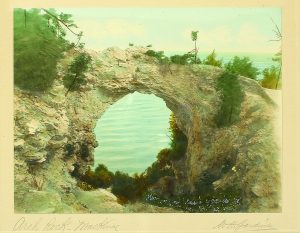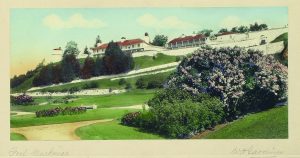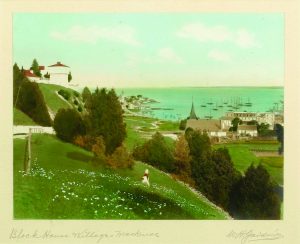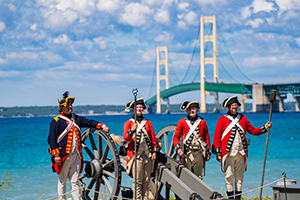 William Henry Gardiner was born in 1861 in Canada, and he began his photography career in Toronto around the age of 20. Around 1890, Gardiner made the decision to move to Detroit, since it was difficult to make a living doing photography in Canada. At some point after moving to Detroit he made a visit to Mackinac Island, and relocated both his family and business there around 1895.
William Henry Gardiner was born in 1861 in Canada, and he began his photography career in Toronto around the age of 20. Around 1890, Gardiner made the decision to move to Detroit, since it was difficult to make a living doing photography in Canada. At some point after moving to Detroit he made a visit to Mackinac Island, and relocated both his family and business there around 1895.
 Gardiner started off by selling postcards and photo packs that featured his own photographs of scenic island locations. After a few years in business he expanded his inventory to include hand-tinted photographs. Other photographers on the island offered prints of the same scenic views, but Gardiner’s colored photographs made him unique. Since Mackinac Island was visited by tourists during the summer months, Gardiner moved his business to Daytona, Florida during the winter. He traveled between Daytona and Mackinac until his death in 1935 while en route to his winter photography studio.
Gardiner started off by selling postcards and photo packs that featured his own photographs of scenic island locations. After a few years in business he expanded his inventory to include hand-tinted photographs. Other photographers on the island offered prints of the same scenic views, but Gardiner’s colored photographs made him unique. Since Mackinac Island was visited by tourists during the summer months, Gardiner moved his business to Daytona, Florida during the winter. He traveled between Daytona and Mackinac until his death in 1935 while en route to his winter photography studio.
Hand-tinted photographs were popular from the mid-19th to early 20th century before the invention of color photography. These photos were created by using brushes, cotton swabs, airbrushes, or fingers to apply oils, watercolors, crayons, pastels, and other dyes and paints to the surface of the black and white photo. Hand-tinted photography was popularized by Wallace Nutting in New England. He created numerous hand-colored scenic photographs of Ireland, New England, and Florida, and inspired many across the country to produce these picturesque images.
W.H. Gardiner’s pho tographs hold some of the most iconic images of the island and they helped promote Mackinac Island as a tourist destination. These hand-tinted photographs gave tourists a perfect souvenir to remember the sites and iconic locations, such as Arch Rock and Fort Mackinac. Today you can find W.H. Gardiner’s hand-tinted photographs on display at The Richard and Jane Manoogian Mackinac Art Museum on Mackinac Island.
tographs hold some of the most iconic images of the island and they helped promote Mackinac Island as a tourist destination. These hand-tinted photographs gave tourists a perfect souvenir to remember the sites and iconic locations, such as Arch Rock and Fort Mackinac. Today you can find W.H. Gardiner’s hand-tinted photographs on display at The Richard and Jane Manoogian Mackinac Art Museum on Mackinac Island.









